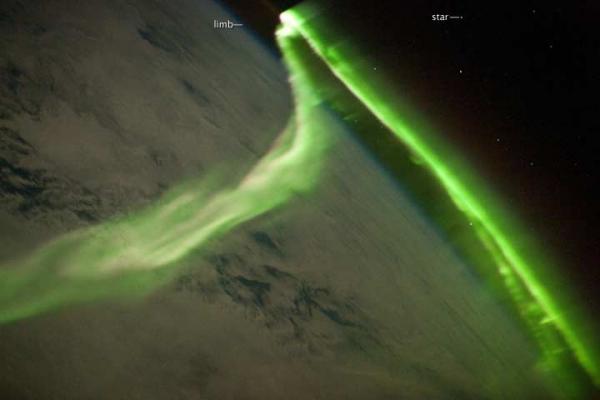
A Guide for Watching Earth's Auroras

In the dark of the night, far from lights, when the moon is down, you may see an eerie glow in the sky, now here, now there, shifting silently from place to place.
Often, its color appears whitish, but occasionally it's a startling red or green. Sometimes it appears as streamers, or as curtains waving in an immense breeze. These streamers of light are a display of the aurora borealis , also known as the northern lights (and southern lights).
While northern lights are usually visible only from the far north, around or above the Arctic circle, during a strong space storm they are commonly spotted in southern Canada and the far northern reaches of the United States. On very rare occasions, they can be visible as far south as Texas. Very dark skies away from city lights are needed to see the aurora.
There's no way to pinpoint precisely where to watch and no time table for when they might appear at any specific place on Earth. But there are certain signs you can watch for.
Solar signs
If news reports say that shortwave radio communications have been disturbed or interrupted, and especially if scientists say it had to do with something happening on the sun, then, that night, the next night and even the next, get out away from city lights and look up generally toward the north.
These conditions are actually happening right now: The sun's surface erupted early on Sunday, and auroras have been visible to people at high northern latitudes.
Sign up for the Live Science daily newsletter now
Get the world’s most fascinating discoveries delivered straight to your inbox.
Solar astronomers observe the sun daily and continually. Special techniques allow these specialists to detect explosions on the sun's surface, called flares. These explosions can range from weak to stupendous.
Flare meets atmosphere
From Earth's vantage point, a flare is a rather sudden brightening of an area near or among sunspots, which themselves are cooler, darker spots on the sun. A small flare might brighten for 20 minutes and then take another 40 to 60 minutes to fade. A great flare may take an hour or more to brighten, not fading away until 3 or 4 hours later. A flare is noticed as a brightening in the ultraviolet and X-ray parts of the spectrum, as well as in visible light.
Auroral displays occur in the outer stretches of the Earth's atmosphere , specifically in a region called the ionosphere, which runs from about 60 to 600 miles (96 to 960 km) above the Earth's surface. At these heights, air molecules are so far apart that space is practically empty like a vacuum, or the inside of a fluorescent tube.
Whenever the sun experiences a significant flare, great streams of charged particles protons and electrons stream toward Earth at terrific speeds; when they hit Earth's atmosphere, they clash with the molecules and atoms of the rarefied gases of the upper atmosphere. These atoms are temporarily stripped of some of their electrons by these collisions and absorb energy in the process. Such charged atoms are called ions. Within a millionth of a second the atoms regain their lost electrons and re-emit this energy in the form of light of various colors.
The electrons that are lost fly around as negatively charged particles. All the extra ions and electrons swirling arund in the atmosphere are responsible for the shortwave and CB skip changes that clue us in to the impending auroral displays.
Northern and southern lights
Actually there is always an overload of electrified particles being sent to Earth, but after taking about 20 to 30 hours to traverse the 93 million miles (150 million kilometers) between the Sun and the Earth, they have become very much affected by Earth's magnetic field. Instead of penetrating any part of the atmosphere, they flow toward the regions of the north and south magnetic poles where the night sky glows eternally with solar overcharge. The aurora at the northern magnetic pole is called aurora borealis, while the ones at the southern pole are called aurora australis (or "southern lights").
Auroras can manifest in many different types of displays: Arcs of light can extend for hundreds of miles or kilometers and start at the horizon and spread upward; long, thin streamers and rays extend toward the zenith and form curtains of light.
Green is the most commonly seen color during major displays; it is caused by the ionization of atomic oxygen. The red colors also often seen are caused by the ionization of molecular oxygen and nitrogen.
Auroral displays appear to be most frequent at the time of greatest sunspot activity. We are now seeing a slow rise toward a peak in sunspot activity which is now expected sometime around the year 2013.











